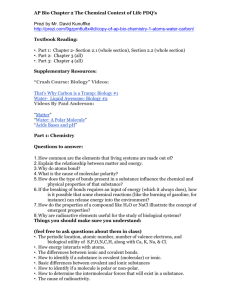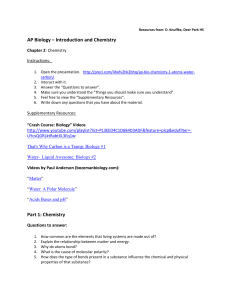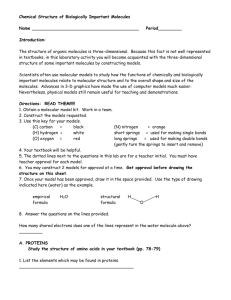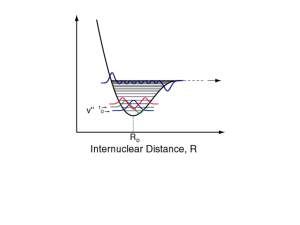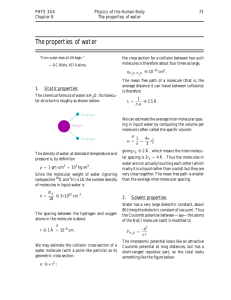Chapter 6 Molecules 6-1 Molecular Bonds Covalent bond: One or
advertisement
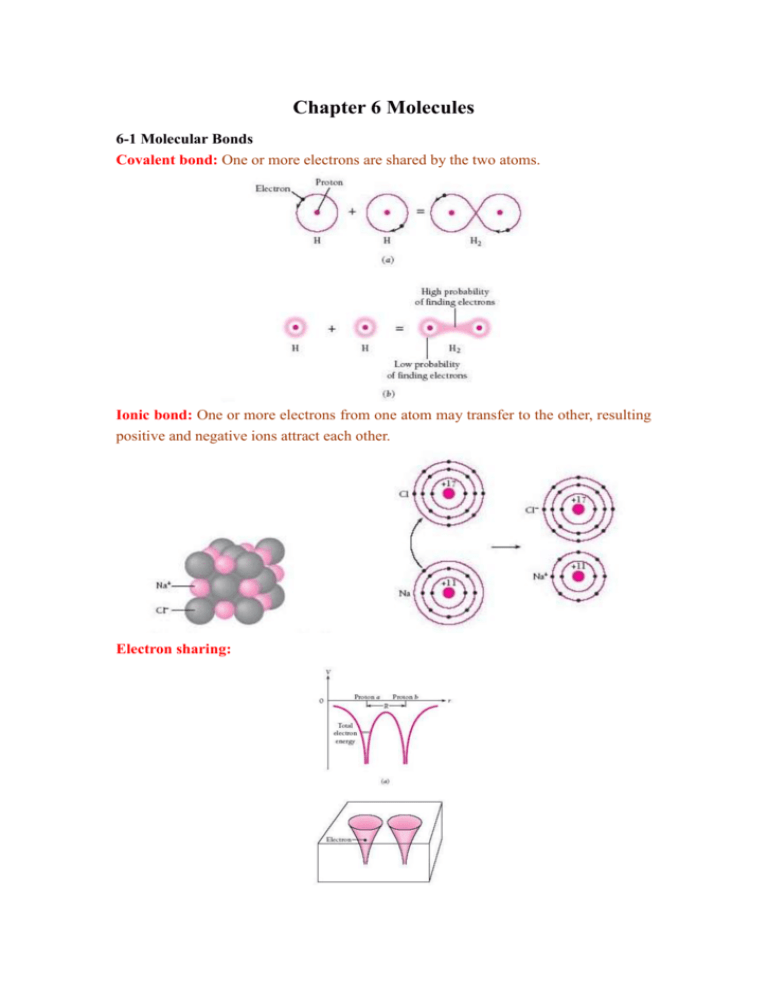
Chapter 6 Molecules 6-1 Molecular Bonds Covalent bond: One or more electrons are shared by the two atoms. Ionic bond: One or more electrons from one atom may transfer to the other, resulting positive and negative ions attract each other. Electron sharing: H2+ molecular ion: Bonding requires two symmetric spatial wavefunctions: ψ(1,2)=ψ(2,1). Antisymmetric spatial wavefunctions can not form chemical bonds. The reason is shown in the following diagrams. But we must obey Pauli’s exclusion principle, the two complete wavefunctions should be antisymmetric. Therefore the two electrons have antiparallel spins. (Proof) The complete wavefunction is Ψ(1,2)=ψ(1,2)s(1,2), where ψ(2,1)=ψ(1,2) but s(2,1)=-s(1,2) Ψ(2,1) =ψ(2,1)s(2,1) =-ψ(1,2)s(1,2)=-Ψ(1,2) Boundary surface diagram for s and p atomic orbitals: Each orbital contains two electrons. There is a high density of finding atoms in the shaded region. H2 molecule: Two H’s with antiparallel form a H2 molecule. H2O molecule: CH4 molecule: Ethylene (C2H4) and benzene (C6H6) molecules: 6-2 Molecular Spectrum Major motions within molecules are rotation and vibration. Molecular rotation: Consider a diatomic molecule that rotates about its center of mass. Moment of inertia: mm I= 1 2 (r1 r2 ) 2 =m’R2 m1 m2 Rotational energy level: EJ=Iω2/2=L2/2I=[J(J+1)] 2/ 2I. Angular momentum: L= J ( J 1) , J=0, 1, 2, … Selection rule of rotational state: △J=±1 Rotational spectra: νJ→J+1=νJ+1→J=|EJ+1-EJ|/h= ( J 1) 2I Eg. A 200Hg35Cl molecule emits a 4.4-cm-wavelength photon when it rotate from J=1 to J=0. Find its interatomic distance. (Sol.) J=0, ν=c/λ= (0 1) I=2.46×10-45 2I The mass of Hg atom=200×1.66×10-27Kg and the mass of Cl atom=35×1.66×10-27Kg m’= m1 m2 I =4.94468×10-26Kg, R= =2.23×10-9m=2.23nm m' m1 m2 Molecular vibration: Consider a diatomic molecule that oscillates harmonically. Frequency of SHM: ν0= 1 2 mm k , where m’= 1 2 m' m1 m2 1 1 k )hν0=(i+ ) , i=0, 1, 2, … 2 2 m' Selection rule of vibrational state: △i=±1 Vibrational energy level: Ei=(i+ Vibrational spectra: νi→i+1=νi+1→i=|Ei+1-Ei|/h= 1 2 k =ν0 m' Eg. The force constant k of CO bond is 187N/m. Find the frequency of vibration of the CO molecule and the spacing between its vibrational energy levels. 1 k =2.04×1013Hz 2 m' -20 △E=|Ei+1-Ei|=hν0=1.35×10 (J)=8.44×10-2eV (Sol.) CO: m’=1.14×10-26Kg, ν0= Fluorescence ( 螢 光 ): Molecules in the ground state absorb short-wavelength photons and enter the excited state. These excited molecules by vibration transitions into the lower energy levels and then drop to the ground state. Therefore they emit long-wavelength photons. It is real-time interaction. Eg. Hg+Ar+UV light→Hg*+Ar*+visible light Phosphorescence (磷光): Molecules in the singlet ground state absorb short-wavelength photons and enter the singlet excited state (S=0). In collision, these excited molecules by vibration transitions into the same energy levels of the triplet excited level (S=1) and then drop to the singlet ground state. Therefore they emit long-wavelength photons. A radiative transition from a triplet state to a singlet state is forbidden by the selection rules, which really mean not that it is impossible but that it has only a small likelihood of occurring. Such transitions accordingly have long half-lives. Phosphorescence radiation may be emitted minutes or even hours after the initial absorption.




